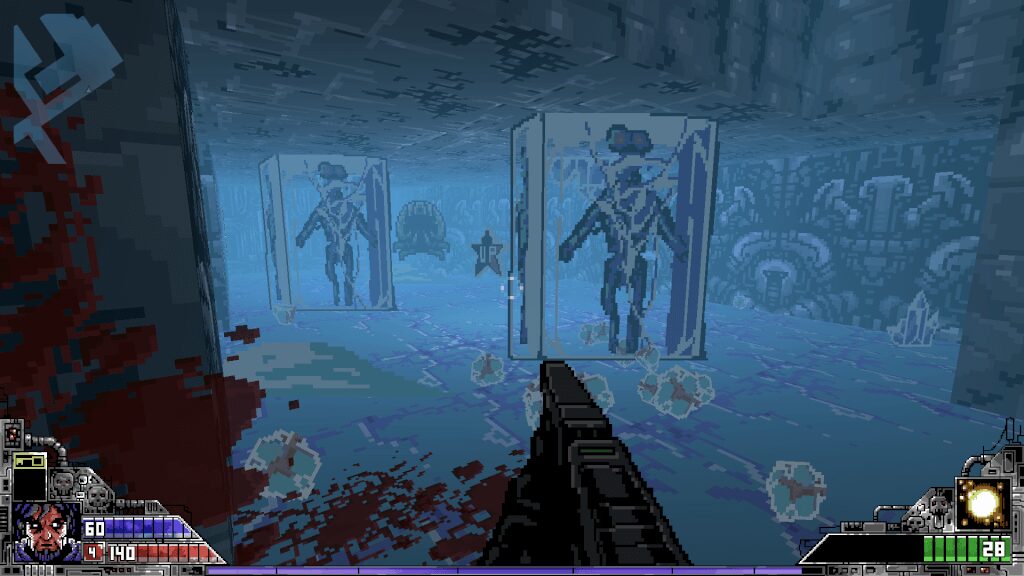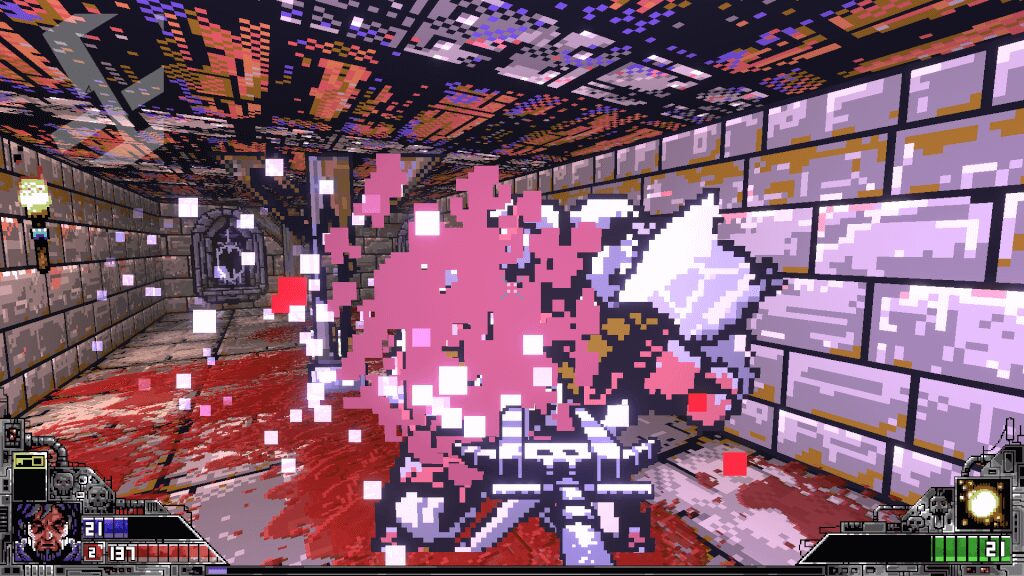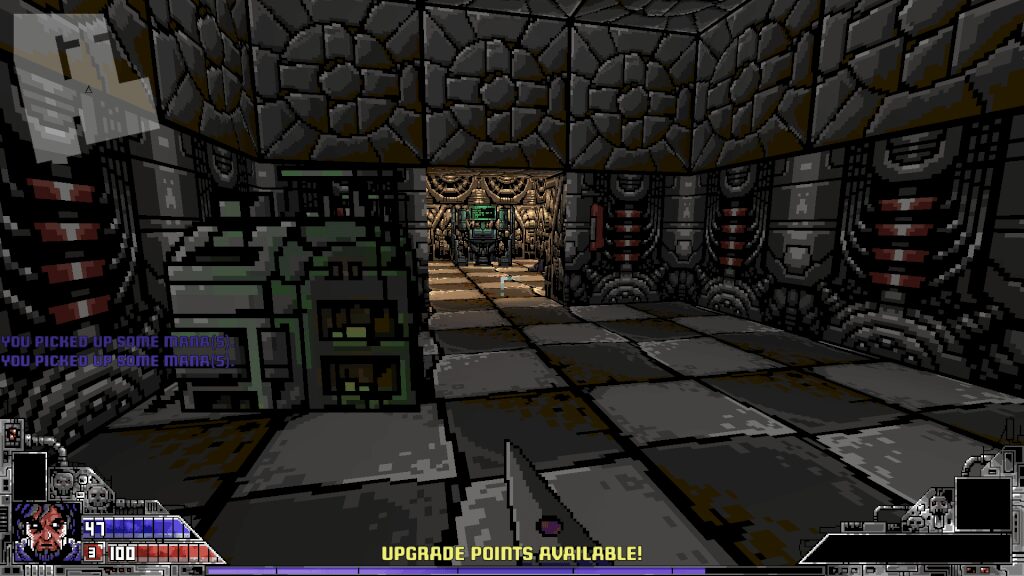If you only buy one retro first-person shooter this year, make it Project Warlock.
I seem to be developing a thing for retro-inspired first-person shooters. First Dusk, then Ion Fury — with a few others in between — and now Project Warlock. Whilst those others are really quite excellent throwbacks, Project Warlock would be worlds apart if it weren’t for a couple of bugs in this console port. From tremendous weapons to a fantastic soundtrack, there’s a lot to love here for fans of the classics.
Project Warlock is clearly based on the likes of Doom, Blood, and Heretic with its sprite-based enemy designs, key-seeking level layouts, and frenetic combat. Playing as the titular warlock, you fight the forces of hell through a variety of time periods before ending up in the underworld to take on the demonic denizens on their home turf. That’s about all the plot you’re getting, aside from the brief end of episode text screens that fill in a couple of blanks. But considering what this game is using as its inspiration that’s pretty much expected. What’s also expected is fast-paced action against swarms of fiendish foes, and Project Warlock delivers this in spades.

Beginning with two melee weapons and a magic staff, you’ll fight through four time periods before taking on Hell itself. Early on, you feel really quite underpowered as there are a fairly large number of enemies at a time, and your only ranged weapon is really quite weak. Once you start to acquire some proper weapons though, you start to feel ludicrously powerful as you take on larger and larger swarms of more threatening enemies. Where once you were fighting bats and zombies, you’ll end up fighting robots the size of buildings and eldritch horrors, and you’ll do so from a genuine position of power.
The weapons you gain during your six-or-so hour campaign are incredibly satisfying to wield. The double-barrelled shotgun is probably one of my all-time favourite shotguns at this point, and the flamethrower destroys most basic enemies in a split-second. Through a combination of brilliantly meaty sound design and animation, you’ll find that the combat is great fun. Even better, you can earn points to modify your weapons as you go. Turn your rocket launcher into a napalm launcher, and make your pistol into a devastating magnum. Once you’ve upgraded a few tools in your arsenal, there’s not a lot that can stand in your way.
There are spells to unlock using the same pool of points too, meaning you can choose to specialise in weapons or magic. Whilst the spells were fun, I found that they ate through your mana pool too quickly to make it a truly viable option, even when you had spent points upgrading it. The shield was a nice addition, as were the magic grenades, but I found it much more useful to put points into health and ammo capacity. Still, it’s nice to have all these customisation options to alter the way you play in future runs.

Each of the time periods you visit is split into four chapters — each then split into two or three stages that last around five minutes each — and a boss stage Each time zone has its own distinct visual style and set of enemies leading to a very large roster of distinct opponents. With Egyptian scarab demons giving way to rocket firing mechs, there’s a constantly fresh array of foes to fight. You’ll succumb to them often enough too, as you tend to be attacked by large groups whether you’re in enclosed spaces or open arenas. Death will cost you a life, and running out of lives sends you all the way back to the start. It’s pretty punishing, but on normal and hard mode there are enough extra life and health pickups to keep you going. Expert mode limits you to one life though and is a brutal challenge for the masochists amongst you. Luckily, the easiest mode removes lives altogether to give you a more manageable experience. This is certainly not a bad choice for your first run, as getting demolished and losing all your lives on a boss stage is pretty infuriating.
The visuals are fantastically well done and make all the enemies and environments look quite unique from zone to zone. The animations look good, with that lovely, almost stop-motion style that classic FPS games featured. I liked the little touch that when you upgrade a weapon it looks distinct from the alternative upgrade you could have chosen, rather than just changing its effect. The arctic zone really stands out in terms of the enemy and environment design. There are some of the most interesting foes here, and there’s clearly some inspiration taken from John Carpenter’s The Thing. The sound is also outstanding here. There’s a great soundtrack that uses the classic midi style and gives you something new as a backing to the carnage from stage to stage. The monsters and weapons sound great too, with the latter in particular being well done. The shotgun and minigun sound like absolute beasts as you let rip into a crowd of demons.
Sadly, there are some bugs, some of which seem to be unique to this console release. Without a keyboard, there’s the now-standard weapon wheel — are you paying attention, Ion Fury? — but it doesn’t seem to work all that well. Holding LB brings it up, and using the left stick selects the weapon you need and you can hit Y to switch between the two weapons in the slot. Sometimes the stick just won’t move the pointer, or occasionally pressing Y will swap to a completely unrelated weapon. Releases then repressing LB will fix this, but when the action is this fast it can be a death sentence, especially considering the weapon wheel only slows rather than pauses time.

More egregious though, are ones that force a level restart considering a level restart will cost you a life. Interestingly, these all revolve around lifts. As there is hardly any verticality in terms of combat in Project Warlock, this may be related to that in some way. Anyway, on one occasion I pressed a button and immediately hopped back in case a door opened and enemies swarmed out. Instead, it sent a lift upwards to the next section of the level. A lift that wouldn’t come back down meaning I was stuck unless I restarted. Another similar occasion had me walk to where a lift went up only to fall through the floor into the eternal abyss of level geometry. Restart! Then there was the final boss who you approach via a lift. A lift that I fell through into a pool of lava. A quick death and restart was the result. Playing on easy mode, this isn’t all that irritating, as you’ll lose at most five minutes of progress. Anything in which you have limited lives, though, is much more frustrating.
These sort of bugs are really poor — I have a personal bugbear with falling through level geometry — and mar what is otherwise an excellent retro FPS. If you can tolerate Project Warlock’s issues as I could, then you’ll be in for a brilliant throwback game that deserves attention. Great soundtrack, great visuals, and great combat, just let down by some technical issues.
Project Warlock is available now on PC, Xbox One, PS4, and Nintendo Switch.
Comments are closed.